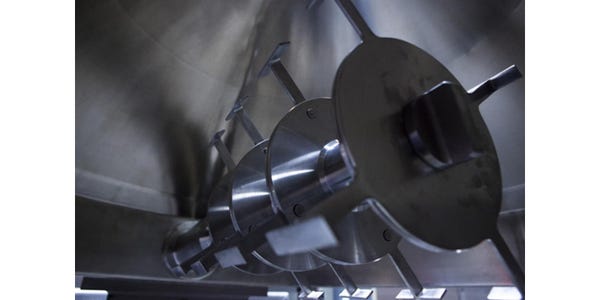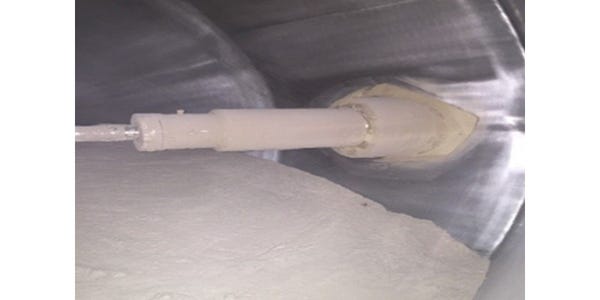Overcoming Challenges to Achieve a Homogeneous Blend
January 19, 2021

Casey Bickhardt, president & CEO, GEMCO
Blending powders is a crucial step for a variety of products that include: pharmaceuticals, nutraceuticals, vitamins, mineral blends, and various foods. Powder blending can also be found in additive metals, chemicals, pigments, plastics, cosmetics, prosthetics, and much more.
For these products, especially for any GMP manufacturing, homogeneity is crucial to providing batch-to-batch consistency and repeatable results. However, one of the challenges behind achieving a homogeneous blend is the disruption of trace amounts of ingredients.
Challenge #1: Achieving Uniformity
Many of these blends and formulas are composed of as many as 40-50 components, some of which include trace amounts of powders (<1%) that vary in size and density. When consideration is not given to a powder’s characteristics (shape, size, and density) the distribution of these active ingredients can be poor.
Imagine trying to mix together star shaped blocks that weigh 5 lb with spheres that weigh 2 oz. It would be extremely difficult to mix these components evenly. Although this is an extreme example, the same concept is happening inside of a blender when particles are not uniform.
Challenge #2: Overcoming Dead Zones Inside Your Blender
With traditional mixing equipment, these machines push material using blades or paddles, which sometimes limits the material’s movement within the vessel. These limitations leave “dead spots” or better known as “dead zones” inside the blender. These spots/zones are where material is left moving slower than the rest of the powders or remains static.
A solution often recommended is for operators to empty the discharge area and manually reintroduce the stationary material back into the mixer. However, this method often leaves portions of the mix to receive more additives than others. Another solution manufactures have found is incorporating an intensifier bar in the vessel’s dead zones. This positioning, however, can still leave material not being properly distributed and active ingredients are left concentrated in certain areas of the mix.

To address these complications, manufacturers have turned to tumble blending to eliminate dead spots. This type of blending uses micro and macro techniques which allow the material to flow freely inside the vessel, falling away from the walls.
Challenge #3: Static Electricity
Believe it or not, static electricity can affect the process of mixing and unfortunately is often ignored. The friction of two materials rubbing against each other causes the “triboelectric” phenomenon known as static charge.
These static charges could potentially cause powders to clump or stick to the walls of the blender. Not only is this dangerous for safety reasons, but you will also not be able to achieve that perfect blend.
The Mixing Zone
Understanding this zone of your vessel can make or break your blend. To get a better look at the mixing zone, we first need to understand micro and macro blending. Briefly mentioned before, tumble blending uses micro and macro techniques to avoid dead zones and evenly distributes material.
Macro blending is achieved by rotating the vessel at a precise speed and angle to allow the material to fall over itself and away from the vessel walls. This uses gravity to mix the material rather than paddles, plows, or spirals. This means less force is used during the blend and allows for sensitive materials to not get destroyed.

During this rotation, micro blending simultaneously mixes the material via agitator blades placed in the center of the unit. This movement allows the material to follow a specific path within the blender to intersect at the center of the vessel. This intersection point is the famous mixing zone.
This design allows for a gentle and repeatable pattern that preserves the product’s physical quality. This method of blending exposes each particle to 6x more active blending per revolution than traditional mixers. More active blending means better homogeneity and excellent product results.
Reaping the Benefits from the Mixing Zone
Challenges such as uniformity, dead zones, and static electricity are eliminated by simply optimizing your machine for the mixing zone.
Particle uniformity is achieved by placing the agitator bar in the mixing zone to ensure all material is being sifted. This eliminates the need for extra steps such as milling or “key blends” because the equipment resizes and disburses the particles during the blend.
Dead zones are no longer a worry since macro and micro blending is in effect. All the material (even trace amounts of ingredients) pass through the mixing zone when tumble blending is being used.
Static electricity is revolved by simply placing arrestors on the blender shafts to properly ground the machine. Your mix will become more effective and stop powders from sticking to each other and to the vessel walls.

By the use of these methods and blending equipment, you are setting your process up for consistent results and validating your machine for repeatability.
Casey Bickhardt is president & CEO, GEMCO (Middlesex, NJ). For more information, call 800-654-3626 or visit www.okgemco.com.
You May Also Like


